Tag: Helsinki
More light! Mehr Licht!
10 January 2013 | In the news
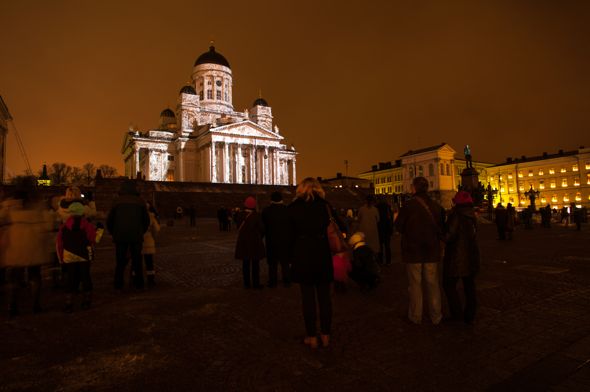
Light and colour: ‘Emergence’ by Casa Magica. Photo: Lux Helsinki / Hannu Iso-oja
With the winter solstice now over, the darkness will begin to diminish, albeit very slowly: additional artificial light is still much appreciated. Fiat lux! The early days of the new year Lux Helsinki (from 4 to 8 Jan) brought light and colour to the city-dwellers in the form of 13 light installations in various parts of the city.
The Cathedral was lit by the German duo Casa Magica – light designers Friedrich Förster and Sabine Weißinger – whose work entitled ‘Emergence’ painted the church with fantastic shapes and colours. One of the works was an illuminated, silvery tram – unfortunately it was not possible to get on board though.
Among the other works of light art was the recently opened and very popular Baana, an old train track now serving as a passageway for cyclists and pedestrians through the city centre: the creation entitled ‘Reveal’ by the London-based media artist Dan Shorten made the stone walls change colour and the total mood of Baana.
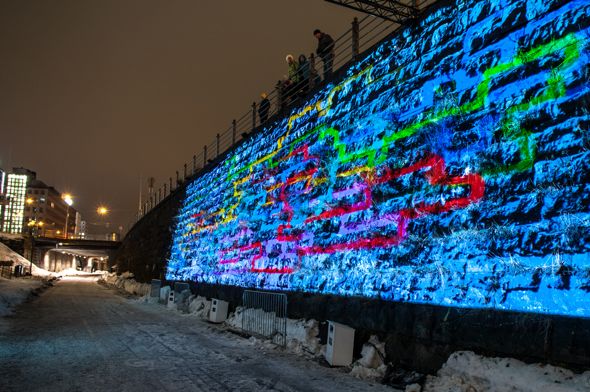
Paint with colour: ‘Reveal’ by Dan Shorten. Photo: Lux Helsinki / Hannu Iso-oja
A pity Lux Helsinki – staged now for the fifth time – lasts for a few days only, as it will take a while for the increase of daylight to be apparent….
Coming in from the cold
13 December 2012 | This 'n' that
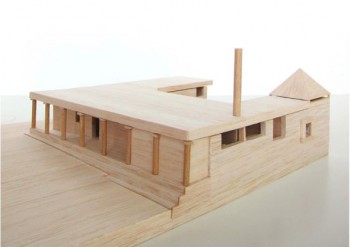
Kulttuurisauna in Helsinki: design by Tuomas Toivonen and Nene Tsuboi
Kulttuurisauna, ‘The culture sauna’, will soon be opened in Helsinki as a part of the World Design Capital 2012 programme. The idea was developed into a project by architect Tuomas Toivonen and designer Nene Tsuboi, a Finnish-Japanese couple who will also run the sauna.
‘When we started considering the idea of building a public sauna in Helsinki, I realised that my dream job is to run a public sauna – offering people a place for cleansing, bathing and sharing quiet togetherness. We have been working in the field of design and architecture for 10 years now, and felt that we can use all of our skills in this project, developing a new public sauna in Helsinki; as a building, as a service and as an environment. By doing this, we want to contribute to the city, participating in making Helsinki more interesting and enjoyable’, says Tsuboi. More…
Stories in stone
9 November 2012 | This 'n' that
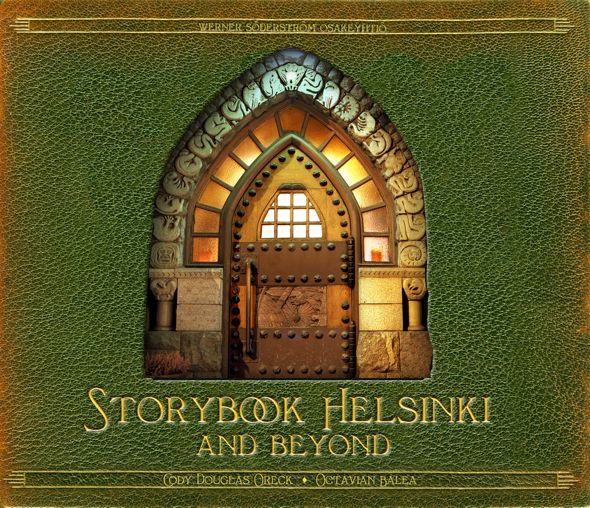 Birds and bees, frogs, squirrels, water lilies, thistles, ferns, junipers, bears and even gnomes originating in Finnish nature appear, in abundance, in Finnish architecture of the two decades around the turn of the 20th century.
Birds and bees, frogs, squirrels, water lilies, thistles, ferns, junipers, bears and even gnomes originating in Finnish nature appear, in abundance, in Finnish architecture of the two decades around the turn of the 20th century.
The trend that developed out of the Arts and Crafts Movement in Great Britain and in the United States, known as l’art nouveau in France and Jugendstil in Germany, lived a short but extremely fervent life in Finland, which adopted the term jugend.
In Finland this aesthetic movement is also called national romanticism. In 1899 the pan-Slavic movement arising in Russia took the form of attempts to suppress Finland’s burgeoning national identity in Finland, and in resisting this, artists made extensive use of national romantic material in their work. More…
Egg in a Cage?
17 August 2012 | This 'n' that
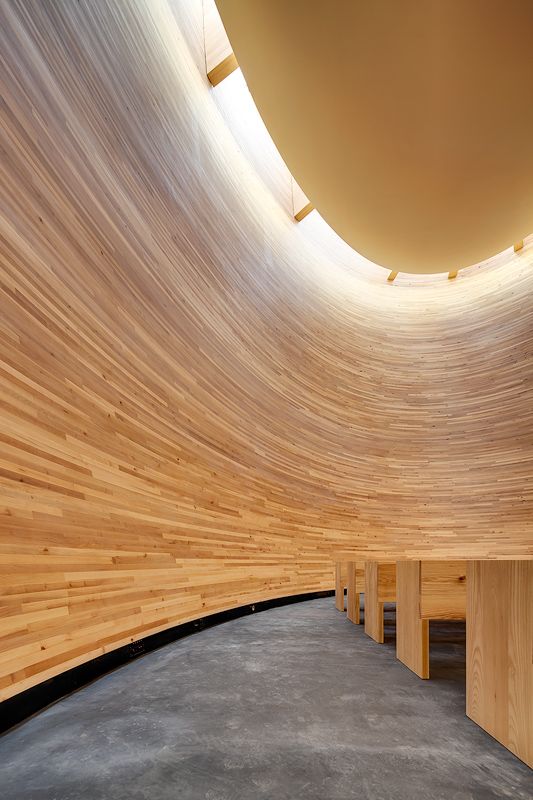
Noises off: the Chapel of Silence. Photo: Mika Huisman/Decopic
A windowless wooden construction with a timber interior sits on a busy route between the bus and railway stations in the middle of Helsinki. The egg-shaped Chapel of Silence contains simple wooden benches, offering a moment of peace and quiet for anyone passing by.
Almost 12 metres high, 270 square metres in overall footprint, it is a sacral space, with a small cross and an altar at the back, but it is not intended for liturgical purposes – however, social services are available for private conversation during opening hours.
Helsinki is this year’s World Design Capital – together with the neighbouring cities of Espoo, Vantaa, and Kauniainen, and Lahti, a hundred kilometres to the north. Every second year the International Council of Societies of Industrial Design recognises one global city `for its accomplishments in utilizing design as a tool to improve social, cultural, and economic life’. More…
Matti Klinge: Pääkaupunki – Helsinki ja Suomen valtio 1808–1863 [Capital City – Helsinki and the Finnish government 1808–1863]
27 June 2012 | Mini reviews, Reviews
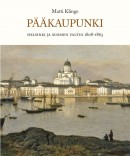 Pääkaupunki – Helsinki ja Suomen valtio 1808–1863
Pääkaupunki – Helsinki ja Suomen valtio 1808–1863
[Capital city — Helsinki and the Finnish government 1808–1863]
Kuvitussuunnitelma [Pictorial design by] Matti Klinge and Yrjö Klinge
Helsinki: Otava, 2012. 509p., ill.
ISBN 978-951-1-26235-0
€ 53, hardback
As a result of the war between Sweden and Russia in 1808–1809, Finland became an autonomous Grand Duchy of the Russian Empire. In 1812 Helsinki was made Finland’s new capital, being more suitable than Turku, the administrative city of the time, as it boasted features such as the coastal fortress of Sveaborg (Suomenlinna), which was important to Russia. In his new book, Emeritus Professor Matti Klinge gives an account of the development of Helsinki as a capital city. Between 1808 and 1843 the Grand Duchy established its central administrative office, its civil service and the University in Helsinki. Tsars Alexander I and Nicholas I wanted Finland to have a monumental capital; Klinge describes the implementation of the carefully detailed city plan and the key buildings. He portrays the work of the individuals who contributed to Helsinki’s development as well as the city’s political, social and cultural life – Helsinki’s history is essentially the history of Finland. Also published in Swedish, this extensive work, which owes its origin to the Historical Commission of the City of Helsinki, is illustrated in a rich and informative manner.
Translated by David McDuff
Christer Lindgren: Stadin klassikot. Maukkainta retroruokaa [City classics. The tastiest retro fare]
18 May 2012 | Mini reviews, Reviews
 Stadin klassikot. Maukkainta retroruokaa
Stadin klassikot. Maukkainta retroruokaa
[City classics. The tastiest retro fare]
Helsinki: Teos, 2012. 135 p., ill.
ISBN 978-951-851-433-9
€32.90, hardback
Even a small metropolis like Helsinki has a few restaurants that have survived the changes of time by sticking to traditional dishes. This book features Sea Horse, Elite, Kosmos and Kolme Kruunua (‘The Three Crowns’), established in 1934, 1932, 1924 and 1928 respectively. Their interiors – stylish art deco and functionalism – date from the 1920s and 1930s. A Sea Horse specialty, fried Baltic herrings, 16 per portion, delighted trumpetist Dizzy Gillespie so much that he ate his, his Finnish host’s and half of a fellow guest’s. The most popular recipes have been influenced by food cooked to the east, north and west (Russia, Lapland, Sweden) and mainly feature meat, fish, poultry and potatoes – cooked with plenty of butter and cream. These restaurants were – and are – frequented by politicians and artists of various fields, so the recipes include ‘Tauno Palo’s cream onion steaks’ or ‘Cod Mannerheim’. It is unfortunate that only the recipes have been translated, not the little stories about the restaurants, so an English reader has no idea who Tauno Palo was (1908–1982; the Finnish equivalent of Cary Grant). The translations sometimes go amiss: a recipe entitled ‘Sautéed reindeer’ first lists a kilo of ‘sautéed reindeer’, when it should of course list ‘a kilo of sliced reindeer meat’. The photos have been shot in situ, so the dishes look nicely authentic.
Panem et circenses, Part II
10 May 2012 | This 'n' that

The Guggenheim Foundation's global network of museums
Helsinki has said no thanks to a new Guggenheim art museum in the city – for the time being, at least.
On 2 May the City Council voted 8-7 against the mayor’s motion to build such a gallery in Helsinki. Politically, the move was supported by the National Coalition Party and the Swedish People’s Party, while the Greens and the left-wing parties opposed it.
What happens after the upcoming national elections – in autumn this year – is another matter. The director of the Guggenheim Foundation, Richard Armstrong, is persistent: he says he wants Helsinki. Well, if the Foundation offers a better deal in the future, the proposal may be considered again.
Three months ago we wondered – see Panem et circenses – whether ‘the people of Helsinki wish to begin to pay additional taxes for the revival, yet again, of the age-old dream of guaranteeing Finland “a place on the world map”, in a situation where economic difficulties are a matter of everyday life for increasing numbers of them? (We believe, incidentally, that Finland already has an appropriate place on the world map.) Will their opinion be asked, or heard?’ More…
Markku Kuisma & al.: Hulluja päiviä, huikeita vuosia. Stockmann 1862–2012 [Crazy days, amazing years. Stockmann 1862–2012]
29 March 2012 | Mini reviews, Reviews
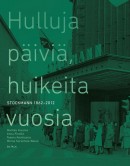 Markku Kuisma & Anna Finnilä & Teemu Keskisarja & Minna Sarantola–Weiss
Markku Kuisma & Anna Finnilä & Teemu Keskisarja & Minna Sarantola–Weiss
Hulluja päiviä, huikeita vuosia. Stockmann 1862–2012
[Crazy days, amazing years. Stockmann 1862–2012]
Helsinki: Siltala, 2012. 532 p., ill.
ISBN 978-952-234-086-3
€37.90, hardback
Also available in English- and Swedish-language editions:
Crazy days, amazing years. Stockmann 1862–2012
Galna dagar, svindlande tider. Stockmann 1862–2012
The largest department store in the Nordic countries, whose current building was completed in 1930 to a design by the architect Sigurd Frosterus, is celebrating its 150th birthday. The Akateeminen Kirjakauppa (Academic Bookstore), owned by Stockmann, is the biggest bookshop in the Nordic countries. The shop founded by the German-born H.F.G. Stockmann has grown into an international business, trading in 14 countries (including Russia, where it has stores in St Petersburg and Moscow). Now quoted on the Finnish stock exchange, Stockmann, owned by a conglomerate of families and foundations, has survived recessions, financial crises and wars. In the 19th century Stockmann was considered an expensive shop for gentlefolk, but as a result of growing competition it has been forced to focus strongly on a diverse concept of service. For decades one of the capital’s best-known meeting places has been ‘under the clock’, outside the main entrance of the department store. The book’s writers are historians from various fields. The generously illustrated work offers new information about the history of trade and the city.
Cityscapes
23 February 2012 | Extracts, Non-fiction
Photographer Stefan Bremer’s home town, Helsinki, provides endless inspiration, material and atmospheric. For forty years Bremer has been recording views of the maritime city, its changing seasons, its cultural events, its people. These images are from his new book – entitled, simply, Helsinki (Teos, 2012)

City kids: day-care outing in Töölönlahti park. Photo: Stefan Bremer, 2010
When I was a child, Helsinki seemed to me a grey and sad town. Stooping, quiet people walked its broad streets. The colours of the houses had been darkened by coal smoke over the years, and new buildings were coated a depressing grey.
A lot has since changed. Today, Helsinki is younger than it was in my youth. More…
C.L. Engel. Koti Helsingissä, sydän Berliinissä. C.L. Engel. Hemmet i Helsingfors, hjärtat i Berlin [C.L. Engel. Home in Helsinki, heart in Berlin]
23 February 2012 | Mini reviews, Reviews
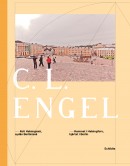 C.L. Engel. Koti Helsingissä, sydän Berliinissä. C.L. Engel. Hemmet i Helsingfors, hjärtat i Berlin
C.L. Engel. Koti Helsingissä, sydän Berliinissä. C.L. Engel. Hemmet i Helsingfors, hjärtat i Berlin
[C.L. Engel. Home in Helsinki, heart in Berlin]
Tekstit [Texts by]: Matti Klinge, Salla Elo, Eeva Ruoff
Valokuvat [Photography]: Taavetti Alin & Risto Törrö
Översättning [Translations from Finnish into Swedish]: Ulla Pedersen Estberg
Helsingfors: Schildts, 2012. 140 p., ill.
ISBN 978-951-50-2183-0
€ 31.50, hardback
The life and works of the German architect Carl Ludvig Engel (1778–1840) are portrayed in four articles by specialists in Finnish history, the history of Helsinki and the history of gardens. Engel spent almost 24 years in Helsinki, transforming it with his architectural designs. For eleven of those years, he and his family lived in a house surrounded by a large garden, both of them his own creations. Looking for work, the young Engel finally found it in the tiny northern town that was pronounced the new capital of the Grand Duchy of Finland in 1812 – both Tsar Alexander I and his successor, Nikolai I, favoured him. From 1816 onwards he designed more than twenty neo-classical buildings, among them nationally important landmarks: the Cathedral, the City Hall, the National Library and the University. Despite his mostly rewarding job as a highly regarded city planner, Engel found Helsinki cold, small and quiet, and he constantly longed for his native Berlin, which he never saw again. However, his flourishing garden gave him great pleasure. Richly illustrated with photographs, the book gives the reader an thorough and interesting picture of this city-changing man and his era.
Life is
16 February 2012 | Letter from the Editors
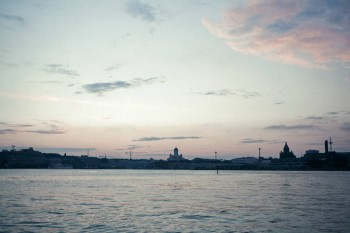
Helsinki silhouette. Photo: Valtteri Hirvonen, Eriksson&Company / World Design Capital Helsinki, 2011
Where is Books from Finland located?
In the old days, the answer was simple, although not unambiguous. Books came from its office in central Helsinki; it was written in various locations in Finland and abroad, and translated mainly in England and the United States; and it was published in the small town of Vammala, about 200 kilometres north of Helsinki.
It spread, in multiple paper copies, to readers throughout the world, to find its place on desks, on bedside tables, in briefcases and handbags, propping up table-legs or holding doors open – in London, England, Connecticut, New England, with a few in Paris, France, and Paris, Texas, maybe. More…
Helsinki: World Design Capital 2012
13 January 2012 | This 'n' that
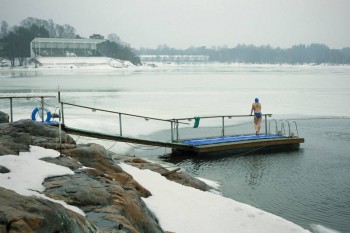
Swimming in the rain: winter joys of Helsinki. Photograph: Valtteri Hirvonen – Eriksson & Co.
After Turin (Italy, 2008) and Seoul (Republic of Korea, 2010), 2012 Helsinki is the third World Design Capital, selected in 2009 by the International Council of Societies of Industrial Design (ICSID).
Helsinki was considered to be a city where ‘design has for decades been a pivotal enabler to building an open city’.
The theme is ‘Open Helsinki – Embedding Design in Life‘. The idea is to improve the everyday life and environment of the citizens and the development of both public services and private enterprises.
In addition to Helsinki, the realisation of the Design Capital year will be carried out by four other cities: neighbouring Espoo, Vantaa and Kauniainen as well as Lahti (some hundred kilometres north of the capital). The Finnish government, two ministries, 21 commercial companies and some universities will co-operate in this project, which has a budget of 16 million euros (2010–2013).
The programme includes some 300 different events, half of them development projects, themed ‘The changing city’ or ‘New solutions’; the other half consists of various exhibitions and encounters for the citizens of Helsinki, tourists and design people.
The ultimate goal of this all is said to be ‘permanent change’. Whatever that really means – good luck!
However, as writer and design critic Kaj Kalin noted in a review in Helsingin Sanomat newspaper (30 December), Finland is full of well-educated designers, but lacks both investment money prepared to take risks and working industry: soon all production will have moved to cheaper countries – and nobody will be able to produce anything. New Finnish design, Kalin argues, mostly approximates merely to ‘a show parade of models and prototypes’.
Away with darkness
28 December 2011 | This 'n' that
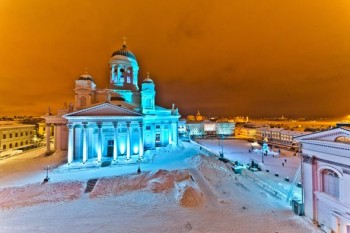
Helsinki Cathedral, lit by Martin Kuhn. Photo: Ralph Larmann
Helsinki is about to celebrate its third Season of Light. A team of designers and artists have created a series of works that will transform the urban milieu and buildings into ‘an experience for the senses and emotions’ in early January (31st December to 9 January).
For example, Helsinki Cathedral will be illuminated by light artist Mikki Kunttu, accompanied by a special sound environment. The light installation will run every day from 5 pm to 11 pm.
The German lighting designer Martin Kuhn will create an installation around Unioninkatu street, using LED technology. It will run from 6 pm to 10 pm.
Take a look at the programme – there are also photo and video samples from the previous Seasons of Light – here.
Who knows whether Helsinki will see any snow at New Year either (Christmas was black this time); nevertheless, these colours will brighten up the darkest hours in the city.
And hey, the winter solstice is already behind us, there is going to be more and more light each day!
Your heart on your sleeve
7 October 2011 | This 'n' that
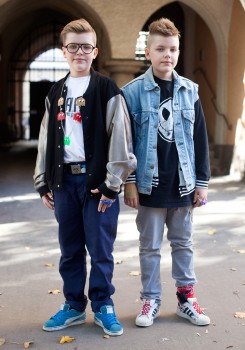
Street cred of Hel Looks: Josua and Julius. Photo: Sampo Karjalainen
The founder of Hel Looks, which charts clothing styles of Helsinki denizens (which we featured here on the Books from Finland website), has been talking to Finnish television (programme in Finnish) about her website.
Established in 2005, the site – which has an eye for the weird and wonderful rather than the classically stylish – attracts an average of 10,000 visitors a day, two thirds of them from outside Finland.
Fashion editor Liisa Jokinen says she got the idea for the site while on holiday in Sweden. ‘I think a lot of Finns admire the Swedes’ fashion sense and in particular their stylishness. But in fact the range of styles is greater in Helsinki, and Finns have the courage to be different,’ she says.
Recent images from the site bear her comments out, and chart the sheer range of costume that she and the photographer Sampo Karjalainen set out to document. Take the 13-year-old fashionistas Josua and Julius (left), snapped on Bulevardi in central Helsinki on 1 October, for example: ‘We dance hip hop and house. It inspires our style. We try not to dress up like all other boys’; or Noel Coward fan Janne, 51, seen on 3 September: ‘I’m wearing an English tweed suit tailor-made in London. I live in Mexico, where I normally wear a white linen suit.’
Best of all, says Jokinen, is when she comes across someone for a second time without realising that she took their picture a year or so back. The image of Helsinki reflected by Hel Looks is made up of people, not buildings. ‘I believe people and their clothes contribute much more to a city than its buildings do,’ Jokinen says.
The photos on the Hel Looks site, currently numbering some 1,200, offer us visions of how people want to be seen; in this selection, few dress to play a role. People wear what they think is fun or/and stylish, and we, the onlookers, enjoy being the judges of this city catwalk.
The sound of music
2 September 2011 | This 'n' that
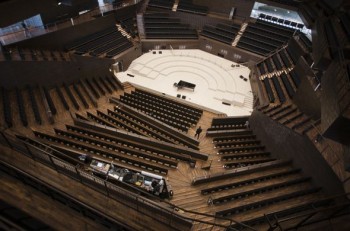
Helsinki Music Centre: the main hall. Photo: Arno Chapelle
The long-awaited new concert hall, Musiikkitalo (’Music house’, in English Helsinki Music Centre), in front of the Parliament house in the very heart of the city, was opened with a concert (this concert is available at YLE Areena until 30 September) featuring Sibelius and Stravinsky on 31 August.
Musiikkitalo finally provides a new home for two orchestras, the Helsinki Philharmonic Orchestra and the Finnish Radio Symphony Orchestra, as well as for the only Finnish university of music, the Sibelius Academy. It is owned by the Finnish government, the City of Helsinki and Finnish Broadcasting Company. The costs of the building rose from an original estimate of 98 million € in 2005 to 190 million €.
The acoustics designer is the renowned Japanese specialist Yasuhisa Toyota. The building, containing seven halls of various sizes, will provide specialised surroundings for different kinds of music and musicians, acoustics in the existing Finlandia Hall (designed by Alvar Aalto) and other local venues long having proved inadequate or faulty.
The site has remained misused for decades: the brick warehouses, dating from the late 19th and early 20th centuries, were finally abandoned by the national railway company in the 1980s and subsequently occupied by various artists’ and civil organisations, housing popular restaurants and flea markets. Many protests took place when the warehouses were doomed to demolition – and then the buildings were finally destroyed in 2006 in a fire.
The brand new concert hall in Reykjavik, Iceland, is called Harpa (‘Harp’). Wouldn’t it have been nice to give also Musiikkitalo a more exciting name to go by – maybe conduct a straw poll among listeners? Some of the rows of seats (1,704 in all) in the main hall resemble logs floating down in a river, so what about Log jam? Or does that have unfortunate connotations for a project that’s meant to provide Finnish music with a new dynamism?
